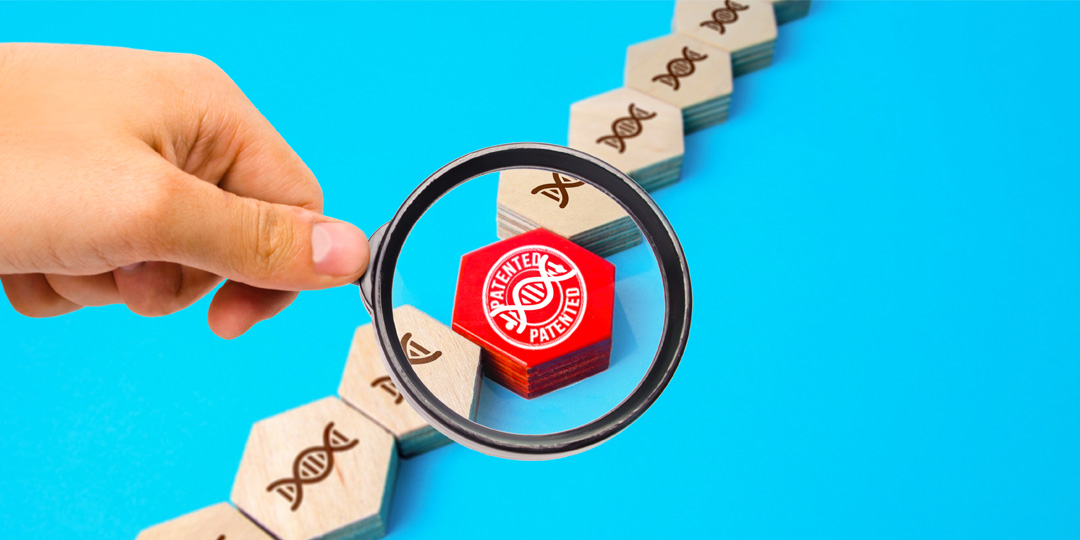PATENTING OF MICROORGANISMS & GENES

VERSHA YADAV
Patent Agent /Patent Associate, Surana & Surana International Attorneys
ABSTRACT
In the 21st century, it is becoming increasingly clear that access to cutting-edge technologies and discoveries can be the difference between progress and failure in the business world. This has led to a rise in patenting of various microorganisms, genes, and viruses.
Although, the government of India permitted patenting of microorganisms in India under the Patents Bill (Second Amendment) on 14th May 2002. The government of India has so far granted many patents for microorganisms, and various pharmaceutical companies and research institutes have filed an application for patenting of microorganisms. But patenting microorganisms, genes & viruses is a contentious issue with ethical, religious, and political implications. On one side of the argument are those who believe that no one should own life forms. On the other side are those who conclude that life forms can be patented and owned like any other invention. In the middle are those who think there should be restrictions on what can be patented.
The ethical debate centers on whether it is morally right to own something alive. In this article, we will gaze closely at the patenting of microorganisms, genes & viruses that are genetically altered with significant human mediation on harmonized global patent systems and also elaborate on the need for a definition of the term “Microorganisms.” We’ll explore what it means for businesses and research institutions and how to acquire or defend a patent in this field in India.
INTRODUCTION
A “Patent” is one of the Intellectual Property Rights relating to a legal document that provides the inventor an exclusive right to their invention for a limited time provided by the government to the Patentee, preventing others from using, selling, or importing them without permission.
Patents provide inventors with a way to secure their ideas and inventions. An inventor can stop others from using or selling their invention without permission by obtaining a patent. In addition, having a patent also allows the inventor to sue those who try to use or sell the invention without authorization. Patents are essential for protecting your work and ensuring you receive the credit you deserve as an innovator. Furthermore, patents can also generate income, making them valuable assets.
Intellectual property (I.P.) law asserts that recognizing and rewarding the innovator fosters industrial and technical progress, paving the way for a vibrant socio-economic structure. Since the invention is essential to growth and development, it is admissible that the same be protected against unnecessary encroachment. This has become more evident in the context of enormous progress being made in the field of biotechnology and information technology. With advancements in biotechnology research and the pharmaceutical industry, pressure started scaling on policymakers to allow patenting of primary life forms to inspire research and development resources, which can devote to exploring the hidden commercial utility of such life forms.
Recent techniques have been advanced to create unique life forms like genetically modified plants & animal species, genes, proteins, cell lines, Diagnostic Kits having microorganisms, and so on, that can be patented as bio-patents. However, the dispute revolves around the limits of such protection. One string of this mystery is the patentability of microorganisms, which requires an analytical analysis of the present position of law and further rumination about its prospects. Sections 27 of TRIPS recognize microorganisms as a patentable subject matter; therefore, many nations have started patenting microorganisms through their domestic patent laws.
PATENTING OF MICROORGANISMS: MEANING AND DEFINITION
A widespread definition of a microorganism is an organism that is microscopic (too small to be seen by the naked human eye) and which can be seen only under a microscope, usually an ordinary light microscope. Microorganisms are enormously divergent and include bacteria, fungi, archaebacteria, and protists, as well as some microscopic plants such as plankton and organisms such as amoeba. Thus, microorganisms consist of single cell or a cell cluster. Numerous definitions of microorganisms could be cited as follows:
- Any microscopic organisms include algae, bacteria, fungi, protozoa, and viruses (The concise Oxford Dictionary).
- Any organism, such as a virus, of microscopic size (Collins English Dictionary).
- Microorganisms are tiny life forms, including microscopic fungi, Protista, prokaryotes, and viruses.
Hence, more than an extract from an English dictionary would be required to define the term ‘Microorganism.’ A technical definition is required to clearly define the scope of exceptions to the patentability discloses in Article 27.3(b) of the TRIPS Agreement. Hence TRIPS Agreement produces ambiguity in defining microorganisms. Recombinant microorganisms have been artificially created by combining the DNA of two or more different organisms. This can be done in a laboratory using techniques such as genetic engineering. Genes is a sequence of nucleotides Present in DNA that is transcribed to provide a functional RNA. There are two different types of molecular genes: protein-coding and non-coding.
During gene expression, the DNA is initially copied into RNA, and then RNA can be directly functional or be the transitional template for a protein that performs a function.
The patenting of microorganisms is a process by which a microorganism is assigned a patent by the government. This process is used to protect the intellectual property rights of the inventor or owner of the microorganism. The Patentee has the exclusive rights to make, use, and sell the invention for a set period. Microorganisms are eligible for patents if they are new, functional, and non-obvious. The microorganisms must also be capable of being reproduced and used in commerce. To be considered unique, a microorganism cannot have been previously disclosed to the public. The microorganism must have some practical utility. Finally, to be non-obvious, a microorganism must be obscure to someone skilled in the art.
The first step in patenting a microorganism is to file a patent application with the territory Patent office. The application contains a description of the invention and claims defining what the inventor believes to be their invention. After filing, the Patent office will review the application to determine whether it meets all requirements for patentability. If it does, the Patent office will grant a patent. In 1873, Antoni van Leeuwenhoek was the first to be given a patent for discovering microorganisms. He found that these tiny creatures were responsible for milk and beer production fermentation. Since then, many other patents have been issued for microorganisms, including those used to manufacture cheese, yogurt, and bread.
BUDAPEST TREATY: DEPOSITION OF MICROORGANISMS & INTERNATIONAL DEPOSITORY AUTHORITY
The Budapest Treaty was signed in 1977 and came into effect in 1980. It is an international agreement that governs the deposition of microorganisms for patenting purposes. Under the treaty, a depositor must deposit their microorganism with a recognized international depositary authority (IDA), who will then issue a certificate of deposit. The treaty requires that the IDA makes the deposited microorganism available to the public upon request and sets out rules on how the deposited microorganism should be handled and stored.
The treaty has been amended several times, most recently in 2000, to include new provisions on digital deposits and transboundary movements of microorganisms. As of September 2018, there are 72 contracting states to the treaty.
The Budapest Treaty allows ‘the deposition of microorganisms at an international depositary authority to be accepted for the patent procedure. In regards of any invention compelling a microorganism, it is impossible to describe it completely. This is why a deposit of biological material must be made in a recognized institution in particular inventions involving microorganisms. The Budapest Treaty ensures that an application, that is a person who claims a patent, must not deposit the biological material in all countries where the Patentee wants to obtain a patent. The applicant needs to only deposit the biological material at one identified institution, and this deposit will be recognized in all countries party to the Budapest Treaty.
INTERNATIONAL DEPOSITARY AUTHORITY
An international depositary authority (IDA) is an organization that receives and stores samples of microorganisms, genes, and viruses to patent them. The IDA acts as a custodian of these samples, ensuring they are available for inspection by patent examiners and potential licensees. The IDA also keeps track of the patents issued for these samples so that they can be appropriately credited to their respective inventors.
The deposition of microorganisms in a culture collection is recognized as an IDA. IDAs will likely transform into ‘biological resource centers’ and further into global common genetic resources with an internationally agreed legal basis for benefit sharing. The deposits are made at IDA in conformity with the rules of the Budapest treaty on or before the application’s filing date. Article 7 of the Budapest Treaty precise the requirements for a facility to become an IDA. As of 1 March 2008, there were 37 IDAs in approximately 20 countries worldwide, and at present, there are 39 IDAs in 22 countries worldwide.
CRITERIA OF NOVELTY FOR PATENTING MICROORGANISMS
A microorganism endures as a part of Nature. Hence its discovery is not an invention. If it is an invention, the rationale of treating scientific theories and fundamentals as non-patentable inventions is defeated. If microorganisms isolated from Nature for a time are considered patentable, then minerals and ores identified from the earth’s interior and deep seabed would qualify for patenting. Thus, microorganisms are viewed as an invention only if the microorganism has yet to be described in the literature and there is a factor of human mediation with the discovery.
Broadly explained, therefore, the invention perception would also beset the kinds of subject matter that require human mediation to make them available in an appropriate form by isolating or purifying naturally occurring products. The TRIPS agreement did not define the word microorganism, and the lack of a commonly acknowledged scientific definition poses the risk of inherently chaotic interpretations by different jurisdictions. Regarding amenability with TRIPS, maximum patent laws do not specifically deal with whether or not a unique living strain of microorganism is itself patentable, but the EPC does not exclude the possibility. The EPO does not grant patents for microorganisms, as the patentability is not explicitly excluded. The present position is thus: Microorganisms are patentable in U.S., Europe, Japan, and all significant jurisdictions under the TRIPS obligation.
Three primary criteria must be met for a microorganism to be eligible for patenting: Novelty, Inventive step, and Industrial Application.
The novelty criterion requires the microorganism to be new, meaning that it has yet to be previously described or disclosed in any public forum. This includes published scientific papers, patents, and other public disclosures. To meet the novelty criterion, the microorganism must also be different from any existing microorganism in at least one materially significant way.
The use/Industrial application criterion requires that the microorganism have some practical use or application. This can be anything from being used as a probiotic to help with digestion to being used to produce a specific chemical compound. The usefulness must be demonstrated for the microorganism to be patented.
The criterion of non-obviousness/Inventive requires that the microorganism not be obvious to someone skilled in the relevant field of art. In other words, the microorganism must offer new or improved functionality over existing microorganisms. This can be something that is a new strain of bacteria that is more resistant to antibiotics.
To be granted a patent, an invention is mandatory to meet the criteria of novelty, utility, and non-obviousness. In the case of microorganisms, these criteria are essential, as there is a great deal of prior art in the field.
PATENTING OF MICROORGANISMS IN INDIA
In the Patent Act of India, 1970, Section 2(1)(j) defines an invention as a new and helpful manner of manufacture or a substance produced by manufacture. No definitions of the manner of manufacture or substances were provided in the Act. Thus, the patent office described a way of synthesizing as a patentable subject matter only if it waves in an embodied nonliving substance.
The 3(j) of the Act stated that plants and animals in whole, or in part thereof, including seeds, varieties, and essentially biological processes for producing plants and animals, are excluded. India joined the Budapest treaty on 17 December 2001, and Microbial Type Culture Collection (MTCC), National cell Culture Science (NCCS), Pune and Gene Bank of the Institute of Microbial Technology, Chandigarh (IMTECH) acquired the status of an IDA marking the amendment of existing systems in India. The position was made more apparent after the 2002 amendment of the Indian Patents Act, 1970, whereby microorganisms can be patented provided they satisfy the other requirements.
CASE STUDY: DIAMOND V/S CHAKRABARTY
Diamond v. Chakrabarty is a landmark case in the field of patent law in the United States. The case involved a patent application by Dr. Ananda Chakrabarty for a genetically engineered bacterium capable of breaking down oil. The case raised questions about the patentability of living organisms and helped to establish the principle that genetically engineered microorganisms can be patented.
In 1980, the U.S. Supreme Court said in favor of Dr. Chakrabarty, finding that the bacterium was a new and functional composition of matter and, therefore, eligible for a patent. The Court stated that living things could be patented if they met the criteria of novelty, non-obviousness, and utility and that they were alive was not a barrier to patentability.
This ruling was significant because it expanded the definition of what could be patented to include living organisms, leading to increased investment in biotechnology research and development. The decision also helped to establish the principle that genes and other biological materials could be patented, which has since become a critical aspect of the biotechnology industry.
However, the case has also been the subject of much criticism and debate, with some arguing that patenting living organisms is ethically problematic and restricts access to essential resources and technologies. The case continues to shape the discussion about the patentability of life forms and the role of patents in the biotechnology industry.
In conclusion, Diamond v. Chakrabarty was a landmark case in U.S. patent law and helped to establish the principle that genetically engineered microorganisms can be patented. The case has had far-reaching impacts on the biotechnology industry and has shaped the debate about the patentability of life forms.
CASE STUDY: DIMMINACO AG V/S CONTROLLER OF PATENTS & DESIGN
DIMMINACO AG v. Controller of Patents & Designs is a case in patent law that was heard in the Indian courts. The case involved a patent application by DIMMINACO AG for a process for manufacturing dimethyl carbonate (DMC) using a novel catalyst. The Controller of Patents and Designs refused the application because the claimed method was an obvious modification of a known process and, therefore, not eligible for a patent.
DIMMINACO AG appealed the decision, arguing that the claimed process was new, inventive, and, therefore, eligible for a patent. The Indian courts agreed with the company, finding that the claimed method was novel, non-obvious, and, therefore, suitable for a patent.
The case is significant because it illustrates the importance of assessing the novelty and non-obviousness of a claimed invention when determining its patentability. It also demonstrates the need for clear and well-defined patent standards to evaluate patent applications consistently and fairly.
In conclusion, DIMMINACO AG v. Controller of Patents and Designs was a case in Indian patent law involving a patent application for manufacturing dimethyl carbonate. The case demonstrates the importance of assessing the novelty and non-obviousness of a claimed invention when determining its patentability and highlights the need for clear and well-defined patent standards.
CASE STUDY: MONSANTO V/S NUZIVEEDU
Monsanto Company v. Nuziveedu Seeds Ltd. is a case in Indian patent law that dealt with the patentability of genetically modified cotton seeds. Monsanto, the developer of genetically modified cotton seeds, had licensed the technology to Nuziveedu Seeds Ltd., a large seed company in India. However, Nuziveedu Seeds Ltd. stopped paying royalties to Monsanto and continued to use the technology without authorization.
Monsanto sued Nuziveedu Seeds Ltd. for patent infringement, arguing that the company’s unauthorized use of the genetically modified cotton seeds violated Monsanto’s patent rights. Nuziveedu Seeds Ltd. argued that Monsanto’s patent was invalid, as it claimed a product of Nature and was therefore not eligible for a patent.
The case went to the Indian Supreme Court, which ruled in favor of Nuziveedu Seeds Ltd. The Court found that Monsanto’s patent was invalid, as it claimed a product of Nature and was therefore not eligible for a patent. The Court also found that the patent needed to be sufficiently inventive and meet the standard of non-obviousness, a requirement for patentability in India. The case has significant implications for the patentability of genetically modified seeds in India and has been widely discussed in legal and academic circles. It highlights the importance of ensuring that patents are evaluated rigorously to ensure that they meet the criteria for patentability and do not restrict access to essential technologies.
In conclusion, Monsanto Company v. Nuziveedu Seeds Ltd. was a case in the Indian patent law that dealt with the patentability of genetically modified cotton seeds. The case was decided in favor of Nuziveedu Seeds Ltd., finding that Monsanto’s patent was invalid as it claimed a product of Nature and was, therefore, not eligible for a patent. The case has significant implications for the patentability of genetically modified seeds in India and highlights the importance of evaluating patents rigorously to ensure that they meet the criteria for patentability.
GUIDELINES FOR EXAMINATION OF BIOTECHNOLOGY APPLICATIONS IN PATENTS
The guidelines for examining biotechnology applications in patents are developed by various patent offices around the world to assist patent examiners in evaluating biotechnology patent applications. These guidelines provide information on the criteria that must be met for a biotechnology invention to be eligible for a patent and the types of biotechnology inventions typically considered patentable.
Some standard criteria that must be met for a biotechnology invention to be eligible for a patent include novelty, non-obviousness, and utility. The invention must also be fully and clearly described in the patent application so that someone skilled in the field can understand how to make and use the invention. Biotechnology inventions typically considered patentable include genetically modified organisms, biological materials such as genes and proteins, and methods for producing or using such materials. However, some biotechnology inventions are not eligible for patents, such as naturally occurring substances and products Nature. In addition to the criteria for patentability, the guidelines for examining biotechnology applications in patents also provide information on the types of evidence that can be used to support a patent application, such as laboratory experiments, field trials, and commercial use.
In conclusion, the guidelines for examining biotechnology applications in patents are developed by various patent offices to assist patent examiners in evaluating biotechnology patent applications. These policies provide information on the criteria that must be met for a biotechnology invention to be eligible for a patent and the types of indicators that can be used to hold a patent application.
CONCLUSION
In conclusion, patenting microorganisms, genes, and viruses is a complex and controversial area of patent law. These biotechnology inventions can be patented if they conform to novelty, non-obviousness, and utility criteria and are thoroughly and clearly described in the patent application.
Patenting these biotechnology inventions can provide valuable protection for biotechnology companies and researchers, allowing them to commercialize their innovations and recoup their investments. At the same time, patenting microorganisms, genes, and viruses can also raise concerns about access to essential medicines and technologies and the potential for monopolies in the biotech industry.
As a result, it is essential for patent offices and policymakers to strike equivalence between preserving the rights of inventors and ensuring that the public has access to critical technologies. Guidelines for examining biotechnology applications in patents can ensure that patent applications are evaluated consistently and fairly and that only truly novel and useful inventions are granted patents.
In addition, ongoing debates exist about the ethical and moral implications of patenting living organisms and genetic material. These debates highlight the need for ongoing discussions and review of the patent system to ensure that it is fair, equitable, and serves the public interest.



